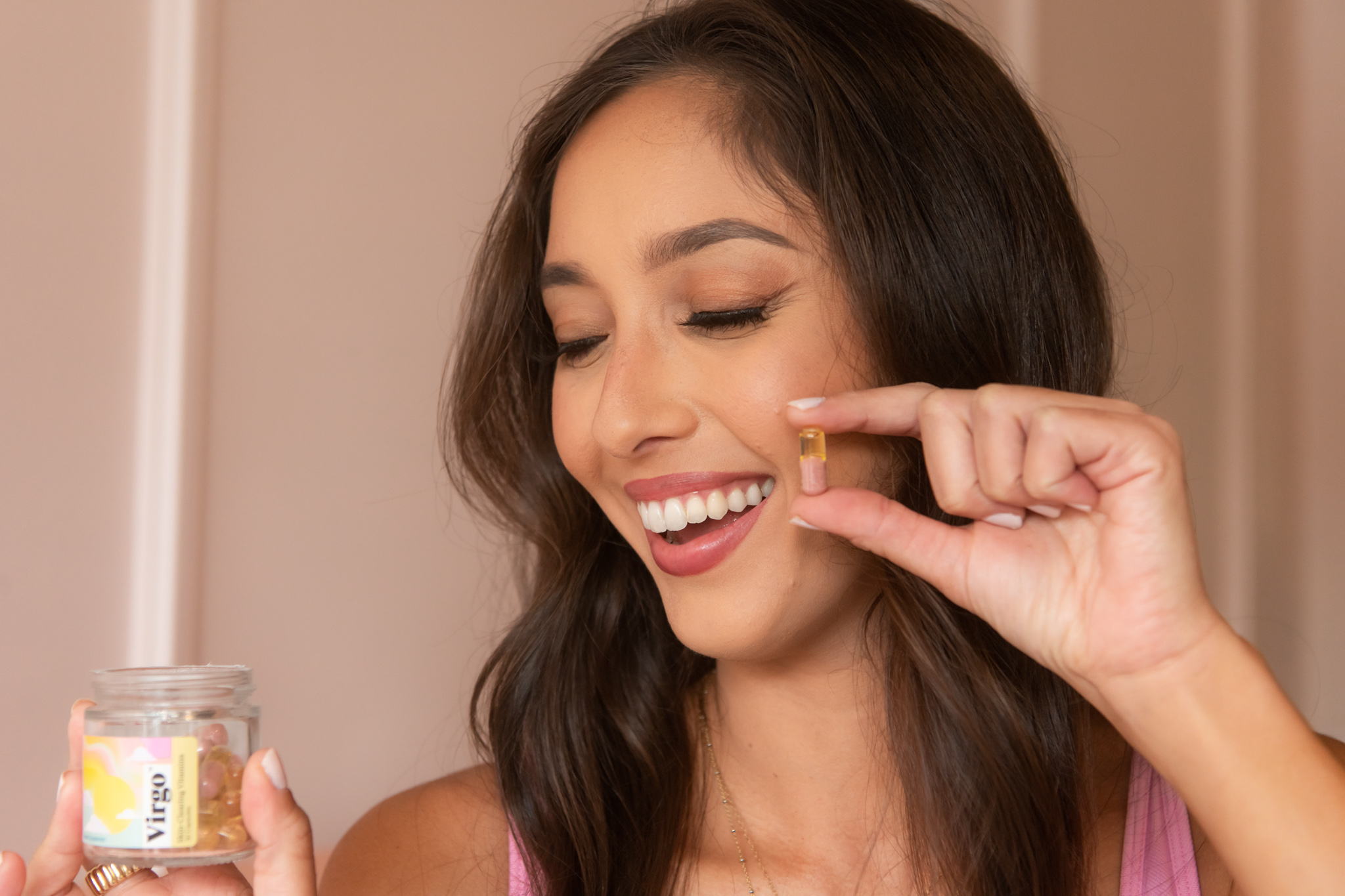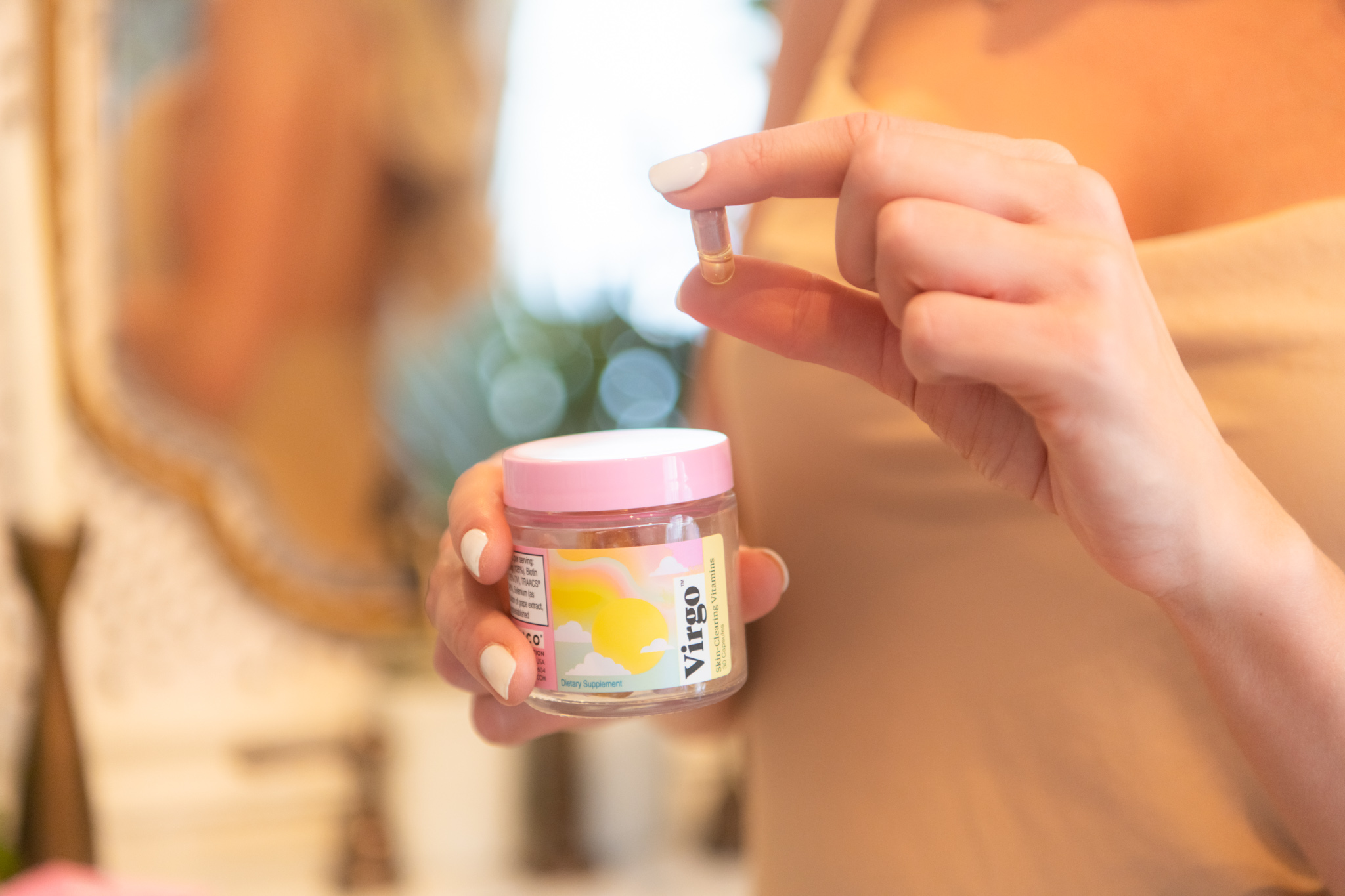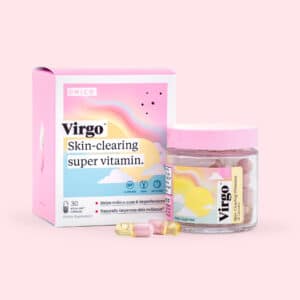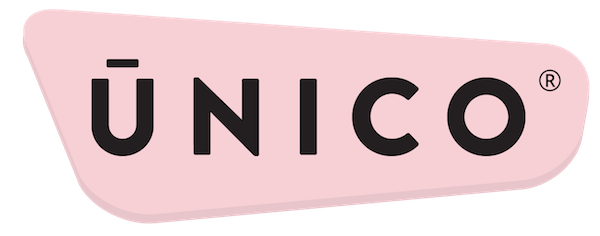Period breakouts driving you crazy? Not only are time-of-the-month breakouts obnoxious, but they are also painful, long-lasting, and can wreak havoc on your self-esteem.
If your period acne woes seem like they’ll never end, and you feel like you’ve tried every remedy possible, maybe it’s time to look beyond the surface of your skin.
More specifically, it might be time to address hormonal imbalances in your body that are likely the culprit of your acne troubles.1

Hormonal Imbalances and How to Spot Them
Hormones are the chemical messengers of the body.2
They come in many different varieties that stimulate specific processes in the body to occur.
A hormonal imbalance occurs when you have too little or too much of one or more of these hormones.2
As a result, essential body processes can go haywire and cause numerous mild to severe health outcomes.
Causes of hormonal imbalances can be both internal and external, but the most common are:3
- Stress4
- Menstruation
- Aging
- Injury
- Medications
- Certain medical conditions (i.e., diabetes, thyroid disease)
Spotting a hormonal imbalance can be difficult because each hormone has its own unique set of signs and symptoms.3
Indicators of imbalance can also vary based on your age and sex.
But luckily, there are common symptoms across hormonal imbalances you should be able to identify, including3:
- Sudden weight gain or loss5
- Elevated sweating
- Increased sensitivity to temperature
- Mood irregularity
- Inflammation of the face
- Poor health of skin and hair
In general, if you suspect you are experiencing an imbalance in your hormone levels, you should address these concerns with your primary care provider.
Hormones and Period Acne: The Connection
When experiencing an imbalance of sex hormones – primarily estrogen and testosterone – you may suffer from noticeably worse-than-usual acne6.
Nearly 65% of those who menstruate suffer from breakouts at and around their period due to hormonal imbalances6.
This unpleasant acne, which usually manifests itself as deep and painful cysts on the chin and jawline, occurs due to natural hormone fluctuations through your menstrual cycle.
As your period begins, estrogen and progesterone levels drop, which can cause your sebaceous glands to secrete excess amounts of oily sebum6.
Too much sebum can clog your pores and lead to breakouts.
In addition, imbalanced hormones can also increase PMS-related stress, increase skin inflammation, and imbalance the skin microbiome, increasing the production of acne-causing bacteria6.
4 Ways to Address Period Acne
If hormonal imbalances and subsequent acne is an issue for you, this news may not be what you wanted to hear.
But don’t despair!
While it may seem that you’ve tried everything to quell your period-skin woes, there are still plenty of research-backed options to provide you relief.
For best success, you will likely have to employ multiple or all options for acne relief during your time of the month7:
1. Choose the right skincare products
If you suffer from acne surges caused by hormone imbalances, a quick rinse of your face in the morning and before bedtime night just won’t cut it.
For fresh, glowing, and blemish-free skin every day, you’ll need to choose skincare products strategically. These products should help control your breakouts while fortifying the overall health of your skin, such as8:
- Gentle cleansers with salicylic acid
- Chemical exfoliators with AHA, BHA, or PHA; limit use 2-3 times a week
- Nourishing moisturizers to replenish your skin barrier (yes, even if you have oily skin)
2. Don’t skip the sunscreen
As hormones shift during your period, they have the potential to compromise your skin barrier.9
The skin barrier is the outermost layer of your skin that protects you from an onslaught of internal and external threats.9
To preemptively protect your skin from menstrual hormone shifts, protect it 24/7 from harmful UV rays by using non-oily sunscreen every day.
3. If needed, see a doctor
Suppose you’re experiencing never-ending period acne. In that case, it may be time to consult with a primary care provider or a dermatologist.
They can help provide intensive therapy for your hormonal imbalance and acne difficulties to provide your skin and body some relief.10
4. Build balance from within
The cause of period acne is much more than just ‘skin deep’.
Hormonal imbalances are an internal issue that your day-to-day lifestyle can influence.2
Therefore, how you care for and nourish your body is an essential part of treating and preventing period breakouts.
An integral approach to balancing your hormonal imbalances and acne is adopting a hormonal acne diet.

What’s a Hormonal Acne Diet?
What you eat is an essential component in managing time-of-the-month acne.
A hormonal acne diet allows you to prioritize foods that help you control your hormone levels, minimize acne, and avoid foods known to stimulate painful period breakouts.11
These foods include those containing high amounts of dairy, refined sugars, and saturated fats.11
Instead, fit more of the following nutrient-packed foods into your hormonal acne diet:
1. Fresh fruits and veggies
Eat plenty of fresh, colorful fruits and vegetables every day that contain high amounts of:12
- Vitamin A
- B-Vitamins (like folate)
- Vitamin D
- Vitamin E
- Zinc
These micronutrients have anti-inflammatory, antioxidant, and even antimicrobial benefits to protect your skin from harm.12
They are also known to aid in cell turnover, helping to slough off dead skin cells and prevent clogged pores.12
You can also try a skin-clearing vitamin supplement to boost the effect of these nutrient-rich fruits and veggies.
2. Probiotics and prebiotic foods
Microbiomes – beneficial ecosystems of trillions of bacteria strains and other microorganisms – exist all over and inside your body.
Those most critical for controlling hormonal imbalances and acne that the gut and skin microbiomes.
Your gut microbiome is essential for balancing hormone levels in your body.13
In contrast, your skin microbiome fends off harmful, acne-causing bacteria from settling on your skin.14
Consuming probiotics and prebiotic foods can fortify beneficial bacterial colonies in both microbiomes.
Probiotics are great for your skin, and can also be helpful for weight loss, and preventing bloating.
High-fiber prebiotics you can eat more of are:
- Onions
- Asparagus
- Berries
- Beans
- Oats and whole wheat
Probiotic foods containing live bacteria strains you can add to your hormonal acne diet include:
- Yogurt
- Kefir
- Sauerkraut
- Kimchi
- Tempeh
- Probiotic supplements
3. Starchy vegetables
Colorful starchy vegetables – specifically those that are yellow-orange – are going to be some of your favorites during your period.
- Some yellow-orange starchy veggies you should know are:
- Sweet potatoes
- Pumpkin
- Butternut squash
- Acorn squash
- Spaghetti squash
Not only are these delicious veggies full of fiber, but they also contain beta-carotene.15
When consumed, beta-carotene the body converts vitamin A – AKA: retinol.15
Retinol is known for its skin benefits, from protecting the skin barrier, fight oxidative stress, and reducing inflammation15.
Still, it also plays a role in proper thyroid function16. An organ essential in controlling balanced hormone release.
4. High-quality and plant-based proteins
Eating enough daily protein is vital for fortifying skin cell structure but also to maintain adequate hormone production.18
However, consuming foods high in saturated fats – red meat, dairy products, etc. – is linked to increased breakouts and imbalance of hormones.18
Instead, focus on lean, high-quality proteins and complete plant-based to meet your daily protein needs. Such as:
- Salmon
- Soy-based products (i.e., edamame, tofu, tempeh)
- Chicken
- Eggs
- Quinoa
- Hemp
- Seaweed and algae (i.e., spirulina or chlorella)
A grass-fed protein powder that is low in fats and sugars can help you get your daily amount of protein.
5. Omega-3 fats
Omega-3 fatty acids are known as “healthy” fats.
Omega-3’s are polyunsaturated that nourish most of your organs while providing antioxidant and anti-inflammatory properties.
These fats help reduce inflammation which is great for your skin, and also great for your brain & mental health.
In fact, Omega-3’s are actually one of the best nutrients for reducing depression & anxiety.
They come in three forms (distinguished by function and food source)17:
- eicosapentaenoic acid (EPA)
- docosahexaenoic acid (DHA)
- alpha-linolenic acid (ALA)
EPA and DHA – found in seafood, shellfish, and marine plants – are the most effective in improving hormonal acne17, mainly due to their inflammation-regulatory properties.17
Find omega-3’s in these foods:
- Fatty fish (i.e., salmon, tuna, sardines)
- Nuts and seeds
- Plant-based oils
6. Anti-inflammatory and antioxidant herbs and spices
Herbs and spices have ancient roots in addressing period acne.
Not only are many of these plant-derived remedies anti-inflammatory and antioxidative agents, but they also show strong potential to balance levels of sex hormones behind severe menstrual breakouts.19
These herbs and spices contain phytoestrogens, which can bind estrogen receptors and have estrogenic and anti-estrogenic effects when hormone levels are unstable.19
Many of the roots that help with acne also have adaptogenic properties.
Some of the most effective you should include in your hormonal acne diet are:19
- Turmeric
- Cinnamon
- Black pepper
- Parsley
- Garlic
- Ginger
- Cayenne
Manage Hormonal Imbalances and Acne Today
If you’ve been a lifelong hormonal acne sufferer, tackling your period breakouts may seem hopeless.
Especially when it feels like you’ve tried everything.
Thankfully, there is still hope!
Consider if you need to adopt one or more of these methods of addressing your period acne today:
- Choose the right skincare products
- Use sunscreen every day
- See a doctor, if needed
- Adopt a hormonal acne diet
In addition to topical remedies for your time-of-the-month breakouts, you’ll want to focus on building balance from within.
Eat to fortify your overall skin health and help control your hormone levels.
Choosing the right foods or skin-clearing vitamin supplements can help reduce, or maybe even eliminate, your hormonal imbalances and acne woes.
Sources:
1https://pubmed.ncbi.nlm.nih.gov/21763298/
2https://www.ncbi.nlm.nih.gov/books/NBK538498/
3https://www.ncbi.nlm.nih.gov/pmc/articles/PMC6276442/
4https://www.ncbi.nlm.nih.gov/pmc/articles/PMC3079864/
5https://www.ncbi.nlm.nih.gov/pmc/articles/PMC4064771/
6https://www.ncbi.nlm.nih.gov/pmc/articles/PMC4142818/
7https://www.ncbi.nlm.nih.gov/pmc/articles/PMC5798558/
8https://www.ncbi.nlm.nih.gov/pmc/articles/PMC6360964/
9https://www.ncbi.nlm.nih.gov/pmc/articles/PMC5967208/
10https://www.ncbi.nlm.nih.gov/pmc/articles/PMC5015761/
11https://www.ncbi.nlm.nih.gov/pmc/articles/PMC5997051/
12https://www.ncbi.nlm.nih.gov/pmc/articles/PMC4428712/
13https://pubmed.ncbi.nlm.nih.gov/28778332/
14https://www.ncbi.nlm.nih.gov/pmc/articles/PMC6678709/
15https://www.ncbi.nlm.nih.gov/pmc/articles/PMC6791161/
16https://www.ncbi.nlm.nih.gov/pmc/articles/PMC5551430/
17https://www.ncbi.nlm.nih.gov/pmc/articles/PMC4884775/
18https://pubmed.ncbi.nlm.nih.gov/26203267/
19https://pubmed.ncbi.nlm.nih.gov/10531758/
Recommended Reading:
- Does Protein Give You Energy? A Registered Dietitian Says ‘Yes’ - December 12, 2023
- Fast vs. Slow Digesting Proteins – Which is Better? - February 20, 2023
- The Top 7 Benefits of Algae – Meet the Sustainable Superfood of the Future - February 8, 2022

